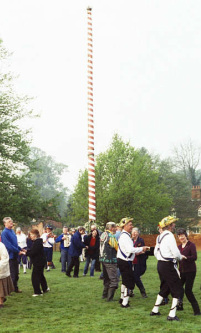From ancient times, the Western world has celebrated spring with a festival at the end of April and starting into May. The Romans called it the Floralia because Flora was the goddess of flowers and as you'll notice, things these days are starting to bloom! In German regions, it's known as Walpurgis Night, but to the Celtic peoples of Ireland and the British Isles called their celebration Beltane. It ran from April 30 to May 1 or even extending to May 3rd or so, though they based it on astrological movements in the heavens, not on the calendar. (They waited for the sun to enter Taurus.) Beltane is the spring fire festival and you can think of it is as the opposite in feeling from Halloween (which these ancient peoples also started in the form of Samhain). If Samhain was dark and scary and oriented toward death and the approaching winter, Beltane was colorful and flirty, all about joy and life and ensuring the fertility of crops, livestock, and human families, too. Of course, in the most ancient of pagan times, there was also a little human sacrifice involved in Beltane celebrations--! Probably not so joyful for that guy, whoever got chosen to end up getting burned on the Beltane fires. Over time, thankfully, the human sacrifice died out (ha, ha, pun intended) and morphed into smaller-scale brushes with the "sacred fire." For example, it was considered good luck to jump over the Beltane bonfire if it was small enough. Or they would build two fires and the daredevils wanting good luck would have to run between them. In other regions, they contented themselves with simply baking a bannock cake over the "lucky" fire and that way, they could consume the good luck. Not all places celebrated the same way. However, if there is one enduring symbol of May Day, it is the charming sight of people dancing around the May pole. Below you'll find a video from an elementary school in England where the little girls from the school demonstrate dancing around the May pole. The video is a little long but if you scroll ahead you'll enjoy, I think, seeing the parents and the rest of the community join in this merry, ancient tradition. It's really pretty adorable. Below that, if you're wondering what the boys were doing on May Day while the girls were dancing around the May pole, it's called Morris dancing! (Nowadays, Morris dancing is for both genders, but originally it was a war- or sword-themed dance for men.) I love seeing modern people committed to ancient traditions handed down to them from centuries worth of their ancestors! Happy Beltane ~ and Enjoy! ~ G.
To find out more details about old Beltane practices, check out this link on Bartleby to this excerpt from Sir George Frazer's 1922 book, The Golden Bough, Ch. 62. And one more video for my romance readers, here's a group of Englishmen singing an old May Day song at a pub in Padstow, Cornwall in exchange for a round on the house. (Not included on the kidlit site because alcohol is shown.) Great voices, and doesn't that look fun! The Padstow May Day celebrations are internationally famous and very old. First written mention dates to 1803, when it would've already been traditional, so known to our Regency-era people.
3 Comments
|
FOLLOW ME ON:
My Latest Release!
Duke of Shadows
A heartbroken belle, a missing suitor, and a heroic duke in disguise. Archives
April 2020
|
Privacy Policy
Cookies Policy
Terms of Service




 RSS Feed
RSS Feed
